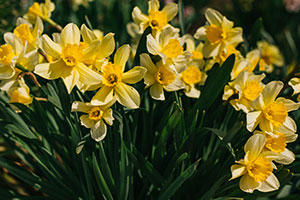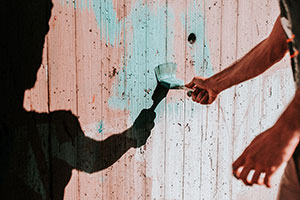Owning a dog and having a beautiful garden do not have to be mutually exclusive; however when tending to your garden and planting for spring it is important to consider the plants and products that can be poisonous, in order to look after your pet’s health. It's a well known fact that foods such as chocolate are toxic to dogs, but there are hundreds of plants which can also pose a danger without owners realising. For example, most mushrooms are non-toxic to dogs so their risks are discussed less, however a small few can cause paralysis or even death so it is safer to remove all mushrooms from the garden if you are unsure.
In the garden, there are three key areas to consider for potential danger to dogs:
Vegetable patch
It is important when planning a vegetable patch to consider which fruits and vegetables can be toxic to dogs if consumed. Onions, for example, can cause gastrointestinal irritation in dogs but the symptoms can occur days later so it is harder to ensure they receive the medical attention they may need. Another example is citrus which can be very poisonous to dogs if consumed in high enough quantities, therefore if you plan on planting citrus trees then be careful and consider how easy it would be for the dog to eat the fruit from the tree or the ground once it has started producing.
Flower bed
There are hundreds of plants that can be poisonous if consumed in a high enough quantity that are commonly planted in flower beds. Although the bulbs should ideally have been planted towards the end of last year, watch out for daffodils and  tulips, as these can cause significant health problems for your dog. The bulbs are very toxic and if ingested can cause serious stomach problems, difficulty breathing and even liver failure. Plants that you could be incorporating in your flower bed as we transition to spring include azaleas and rhododendrons, which can also put your pet in severe danger. These plants contain toxins that can lead to vomiting, diarrhea and more seriously a coma which can eventually lead to death. An extensive list of plants that can cause ill health in dogs can be found on sites such as Dogs Trust.
tulips, as these can cause significant health problems for your dog. The bulbs are very toxic and if ingested can cause serious stomach problems, difficulty breathing and even liver failure. Plants that you could be incorporating in your flower bed as we transition to spring include azaleas and rhododendrons, which can also put your pet in severe danger. These plants contain toxins that can lead to vomiting, diarrhea and more seriously a coma which can eventually lead to death. An extensive list of plants that can cause ill health in dogs can be found on sites such as Dogs Trust.
It can be difficult to know if your dog has ingested a poisonous substance because the symptoms can vary significantly, from diarrhea to loss of consciousness. If you suspect that your dog has been poisoned, there are 4 steps to follow:
- Stay calm and remove your pet from the source of poison if it is safe to do so
- Contact your vet immediately
- If possible, identify the source of poison
- If appropriate, collect contained evidence to take to the vet e.g. the pesticide bottle or a picture of the plant ingested
Garage/Shed
Although now might be an ideal time to use lawn treatments and pesticides to get the garden looking refreshed for spring/summer, these products can be very toxic to dogs. If a dog has walked on a treated lawn before the product has been properly soaked in, there is a good chance they will lick their paws later on and they can become very ill from ingesting the chemicals. When looking for lawn treatments or other chemical based garden products, be sure to read the warnings in full, and look for labels that specify if they are pet safe - this usually means they are free of herbicides/pesticides and absorb into the lawn quickly so that your  pet is less likely to get any leftover treatment on their paws.
pet is less likely to get any leftover treatment on their paws.
Another product that can be used to prepare the garden for spring but can pose health risks to your dog is fence paint. Broadly speaking, there are 4 types of garden fence preservatives: clear, coloured, solvent-based and water-based. The best option for your garden if you have pets is water-based, because they have a lower percentage of volatile organic compounds (VOCs) than solvent-based preservatives. The compounds can cause a toxic reaction in dogs if they are exposed to high levels, which can make them really sick. However, it is important to note that although water based paint is considered non-toxic, dogs can still become sick if they consume significant amounts of the paint so it needs to be stored safely.
Advice from Groomers


 tulips, as these can cause significant health problems for your dog. The bulbs are very toxic and if ingested can cause serious stomach problems, difficulty breathing and even liver failure. Plants that you could be incorporating in your flower bed as we transition to spring include azaleas and rhododendrons, which can also put your pet in severe danger. These plants contain toxins that can lead to vomiting, diarrhea and more seriously a coma which can eventually lead to death. An extensive list of plants that can cause ill health in dogs can be found on sites such as
tulips, as these can cause significant health problems for your dog. The bulbs are very toxic and if ingested can cause serious stomach problems, difficulty breathing and even liver failure. Plants that you could be incorporating in your flower bed as we transition to spring include azaleas and rhododendrons, which can also put your pet in severe danger. These plants contain toxins that can lead to vomiting, diarrhea and more seriously a coma which can eventually lead to death. An extensive list of plants that can cause ill health in dogs can be found on sites such as  pet is less likely to get any leftover treatment on their paws.
pet is less likely to get any leftover treatment on their paws. 